Yeah, there’s a giant bunny in that vineyard and 9 animals, vegetables and antlers you’ll want to stop and see
- Share via
If someone told you about a giant bunny hanging out in a Napa vineyard, you might suspect he or she had sampled too much of the grape or, given the date, was an April Fool's prankster. You’d be wrong in either case. There is a bunny — a very big bunny — hopping around wine country. He (or she) certainly must be a cousin of a giant dog in Denver, three large yellow hats in Salinas, Calif., and many other supersized attractions. Now you might argue that these works are visual junk food, not art. Could be. But they’re also whimsical reminders that vacation can loosen the bonds around our workaday brains and let us suspend reality, if only for a little while. We’ve gathered 10 from California and the West that we think are worth a detour.
Fort Stockton, Texas
Not all roadrunners rate their own Google Maps designation. Paisano Pete does.
The supersize Fort Stockton mascot is 22 feet long and 11 feet tall and has greeted visitors to this West Texas frontier town since 1980.
Pete, who stands midstride on giant legs, received his handle in a naming contest.
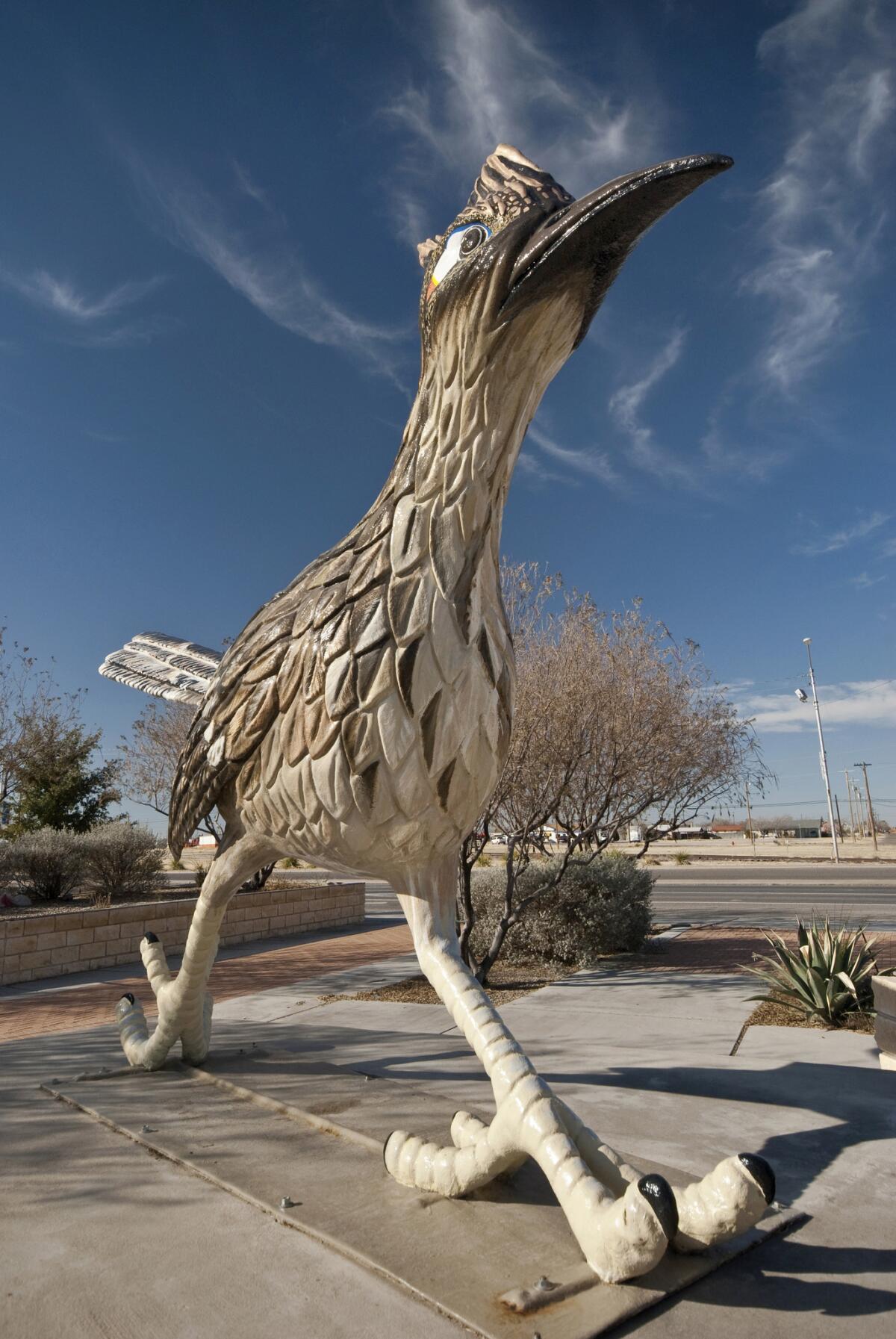
The big bird is reason enough to jump off the lonely stretch of Interstate 10 between El Paso and San Antonio to take a look. Alas, Pete isn’t the biggest faux roadrunner around (one in Las Cruces, N.M., stands 20 feet tall), but he’s the biggest thing Fort Stockton has going.
What to know, where to go: It’s a 10-minute turnoff from the interstate to Main Street and Dickerson Boulevard. Park at the nearby visitor center and cross the street to line up the kids for a photo. Historic Fort Stockton Convention & Visitor Bureau
Denver
One of the most beloved dogs in the Rocky Mountain state stands guard outside the Denver Animal Shelter. “Sun Spot” rises to 20 feet and is made from 90,000 stainless-steel dog tags attached to a mesh base.
The tags tinkle in the wind and give the dog a permanent sparkle. At night, LED lights bathe him in an orange-reddish glow.
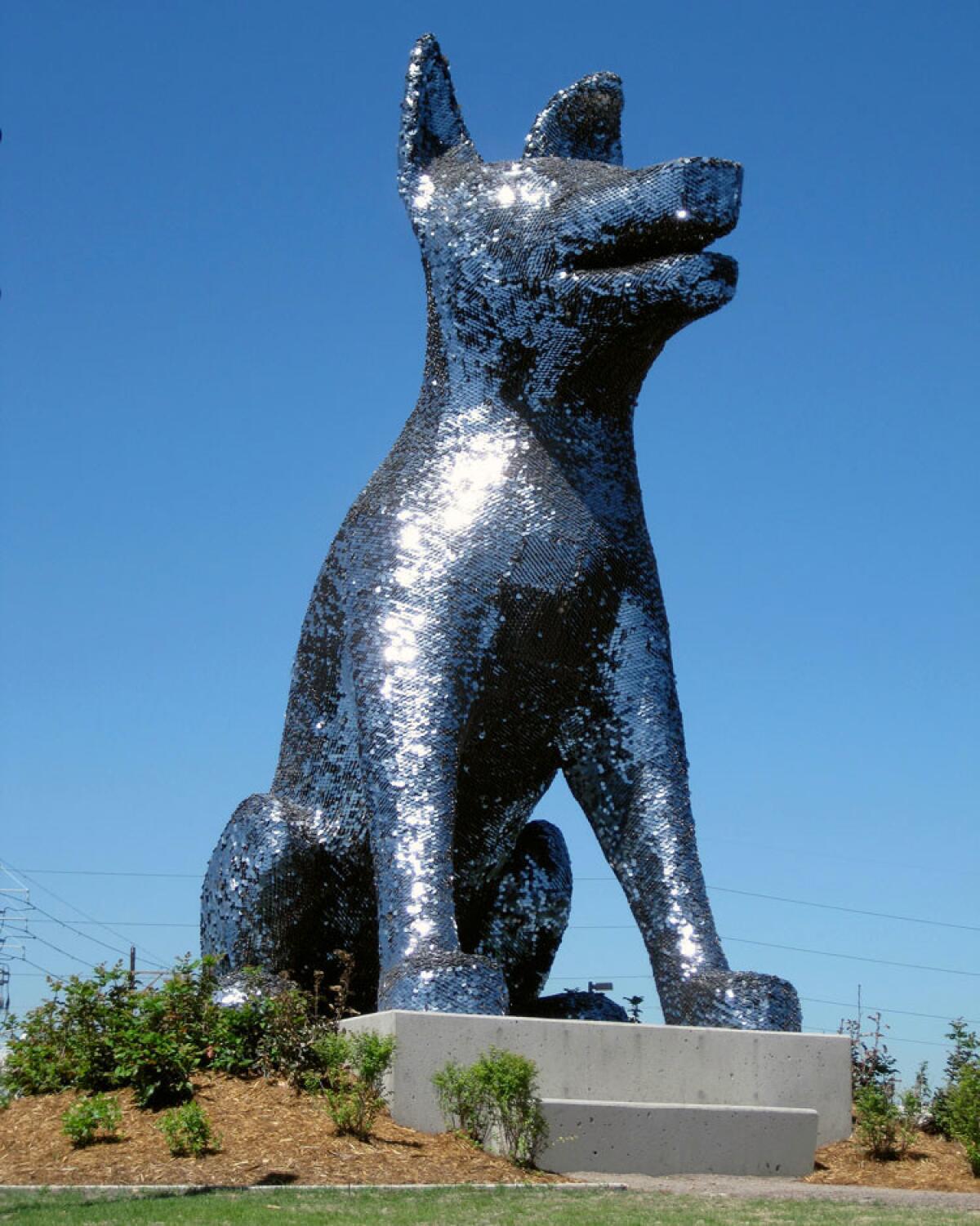
You can see “Sun Spot” from Interstate 25, but it’s best to visit the shelter to take a photo. Go inside the LEED-certified building and you’ll find “Sun Spot”’s enormous dog collar.
Make a donation and you can hang a tag on the collar inscribed with the name of your pet — or maybe, while you’re at the shelter, find a new four-footed companion.
What to know, where to go: Try to go on a sunny day when the dog is at his sparkly best. You’ll find “Sun Spot” at the Denver Animal Shelter,1241 W. Bayaud Ave.
Jackson, Wyo.
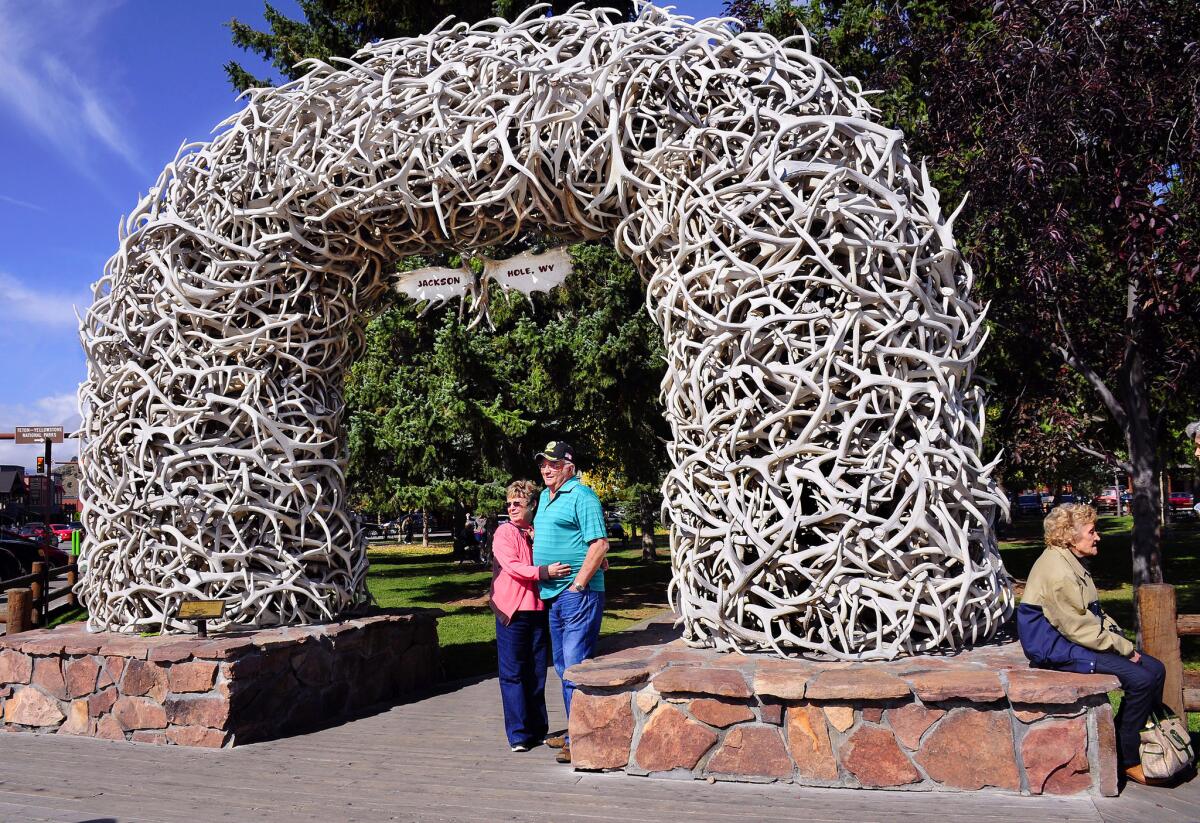
No elk was harmed in the making of four remarkable 15-foot antler arches in the center of Jackson. Each arch is made from about 2,000 antlers woven onto a steel frame and weighs up to 14,000 pounds.
Elk shed their majestic racks in spring. The antlers were collected at the nearby National Elk Refuge. The first arch went up in 1953 and became so popular with visitors, the city created three more in the 1960s.
Since then, they’ve been replaced after becoming brittle and battered by the elements.
If you want to take home a pair of antlers, visit Jackson during the annual ElkFest on May 19 and 20 when the local Boy Scouts host their 51st antler auction. Last year, they brought in $178,000, most of which will be spent on making improvements at the refuge.
What to know, where to go: Head to Jackson’s town square, officially known as George Washington Memorial Park, 10 E. Broadway. You can’t miss the creepy yet beautiful arches on each corner. Jackson Hole & Greater Yellowstone Visitor Center
North of Roswell, N.M.
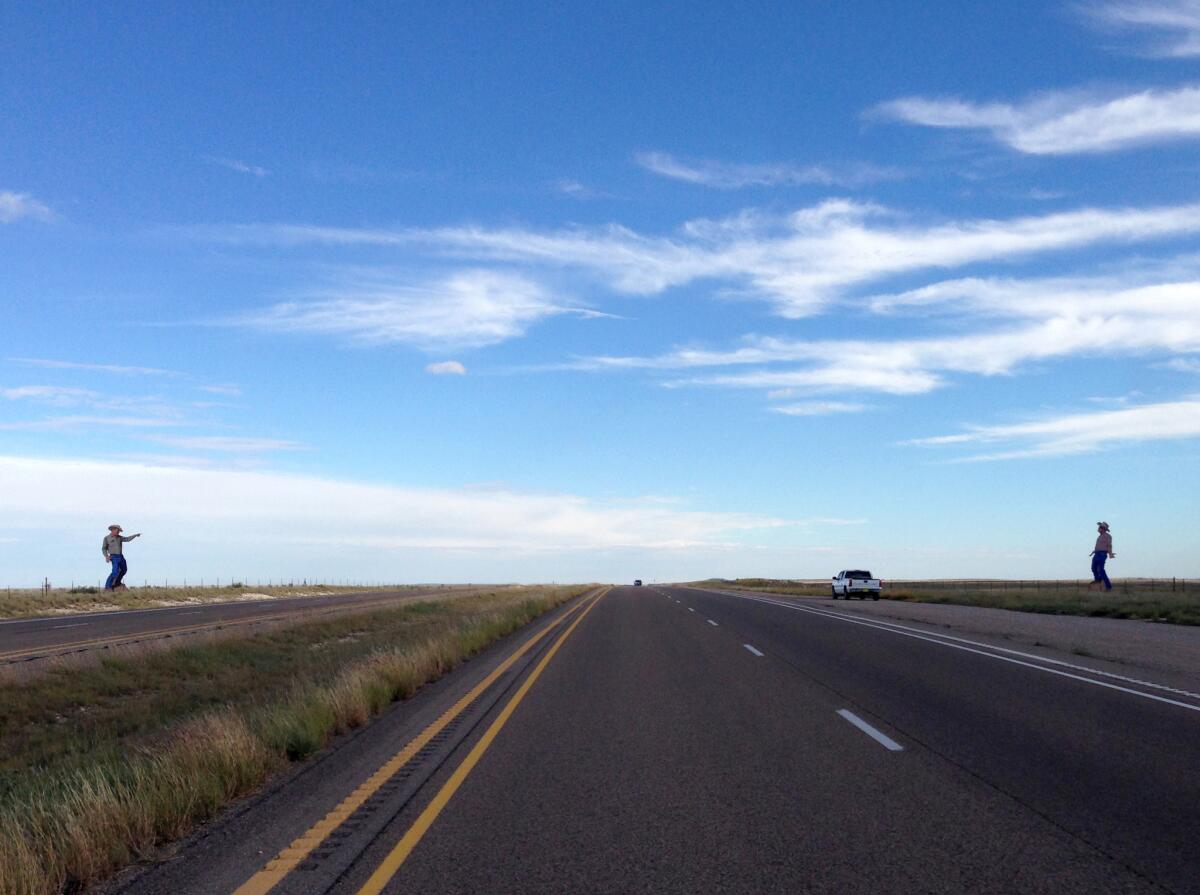
Next time you’re driving on a quiet highway north of Roswell, N.M., look for two 18-foot-tall cowboys on opposite sides of the four-lane road. The wooden cutouts point and glare at each other in stances that suggest they’re itchin’ for a fight.
“I wanted the viewer to be part of the scene, so you’re driving in the middle of the argument,” said John Cerney, the Salinas, Calif., artist who created the pair.
The open spaces became the ideal canvas for re-creating a fight he once witnessed (although the combatants were prostitutes, not cowboys) in his signature super-sized art.
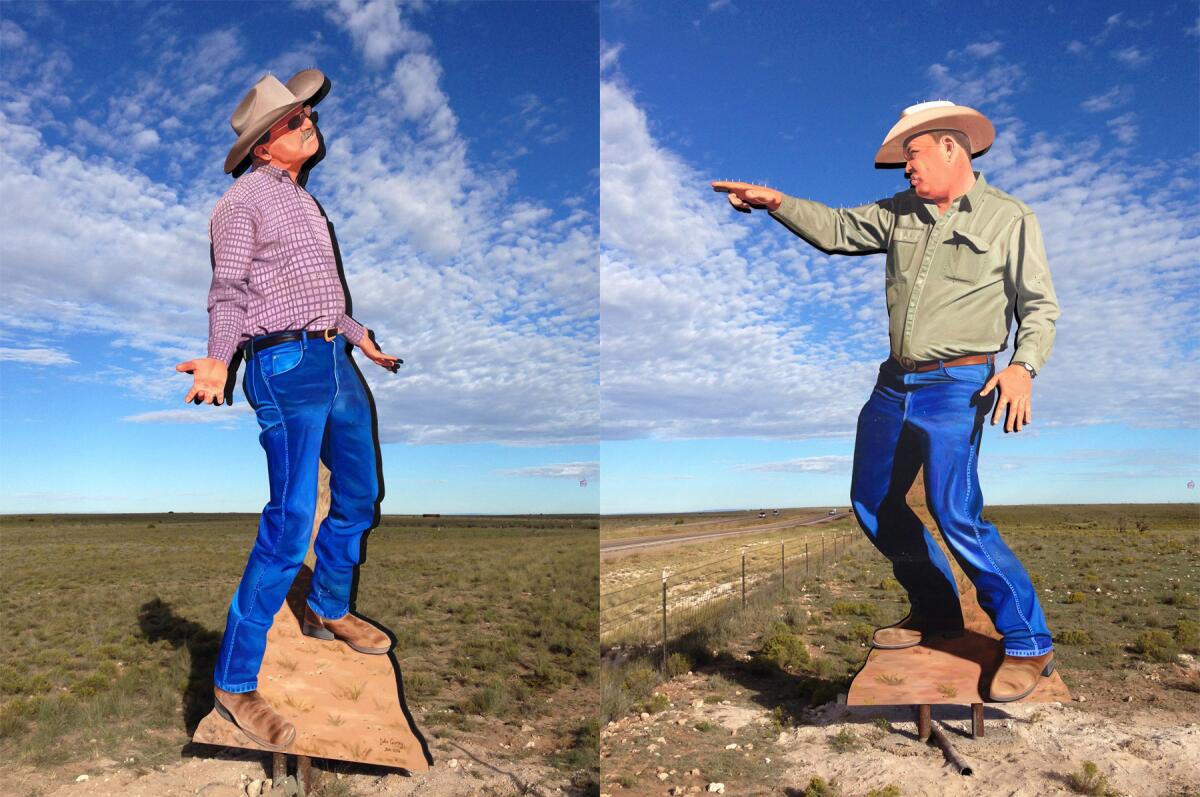
The sneering cowboys are based on two brothers who own the land on which their likenesses stand. (They get along in real life.)
What to know, where to go: You’ll find “Cowboy Ruckus,” as the artwork is called, on U.S. 285, 73 miles north of Roswell. It doesn’t matter which direction you’re driving; the cutouts are double-sided. Pull over and you can walk to the figures.
Klamath, Calif.
Visitors on U.S. 101 in Klamath for decades have slammed on their brakes and pulled over to gawk at the mega-mighty Paul Bunyan and Babe the Blue Ox. The pair is unforgettable.
Bunyan, whose face has a permanently startled look, is 49 feet tall and has a 52-foot waist. He waves and sometimes speaks. Most people strike a pose on the toes of his 10-foot-tall boots.
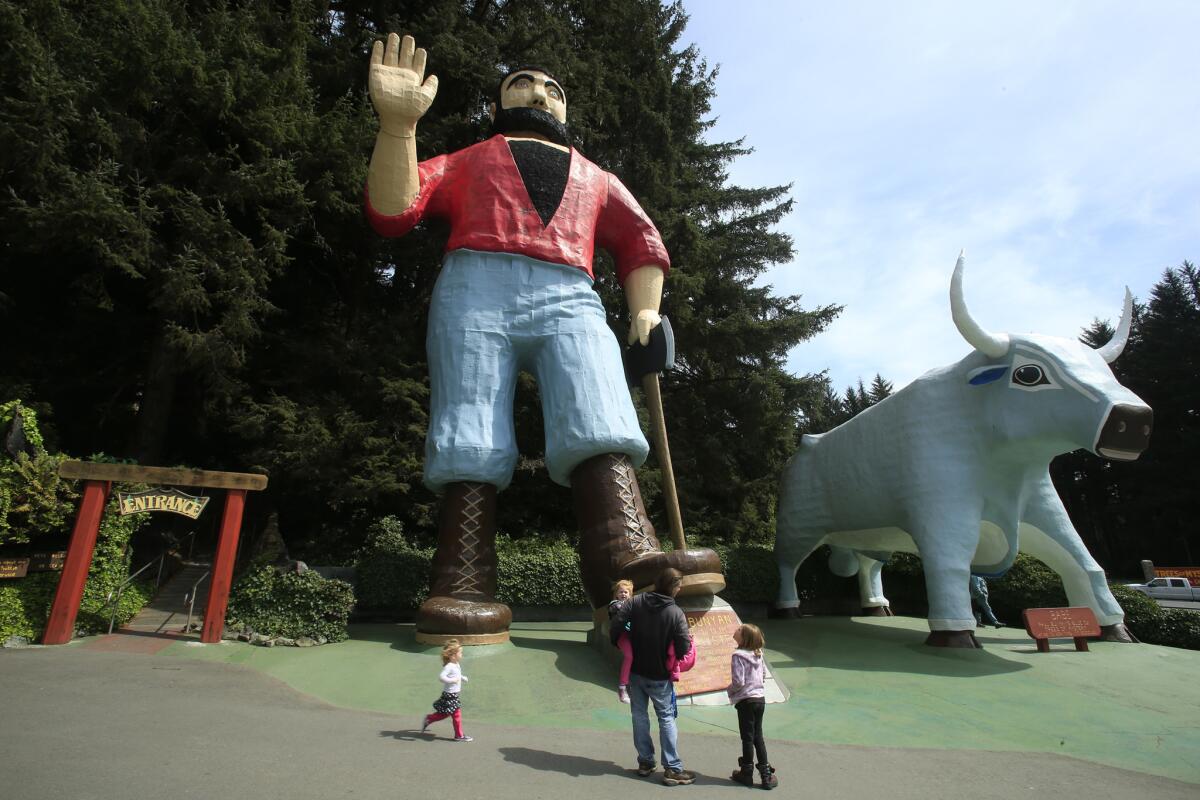
Babe measures 35 feet, from the ground to the tip of her horns.
It’s easy to stop and photograph the pair for free outside the Trees of Mystery redwood attraction. But Paul’s story continues amid carvings and big trees on the Trail of Tall Tales. See what he did there? Sucked you right in.
Where to go, what to know: You can’t miss these two on U.S. 101 about 36 miles south of the Oregon border. Checking out the trees and trails costs $18 for adults, $9 for kids 6 to 12. Trees of Mystery
St. Helena, Calif.
When you see a 35-foot gleaming rabbit leaping over vines in California’s wine country, pull over. The rabbit at the entrance to Hall Napa Valley winery in St. Helena has become such a popular roadside surprise there’s a sign that tells visitors the best place to stand to take a selfie.
“Bunny Foo Foo,” created by artist Lawrence Argent, takes its name from a children’s poem (“Little Bunny Foo Foo/hopping through the forest/scooping up the field mice/and bopping them on the head”).
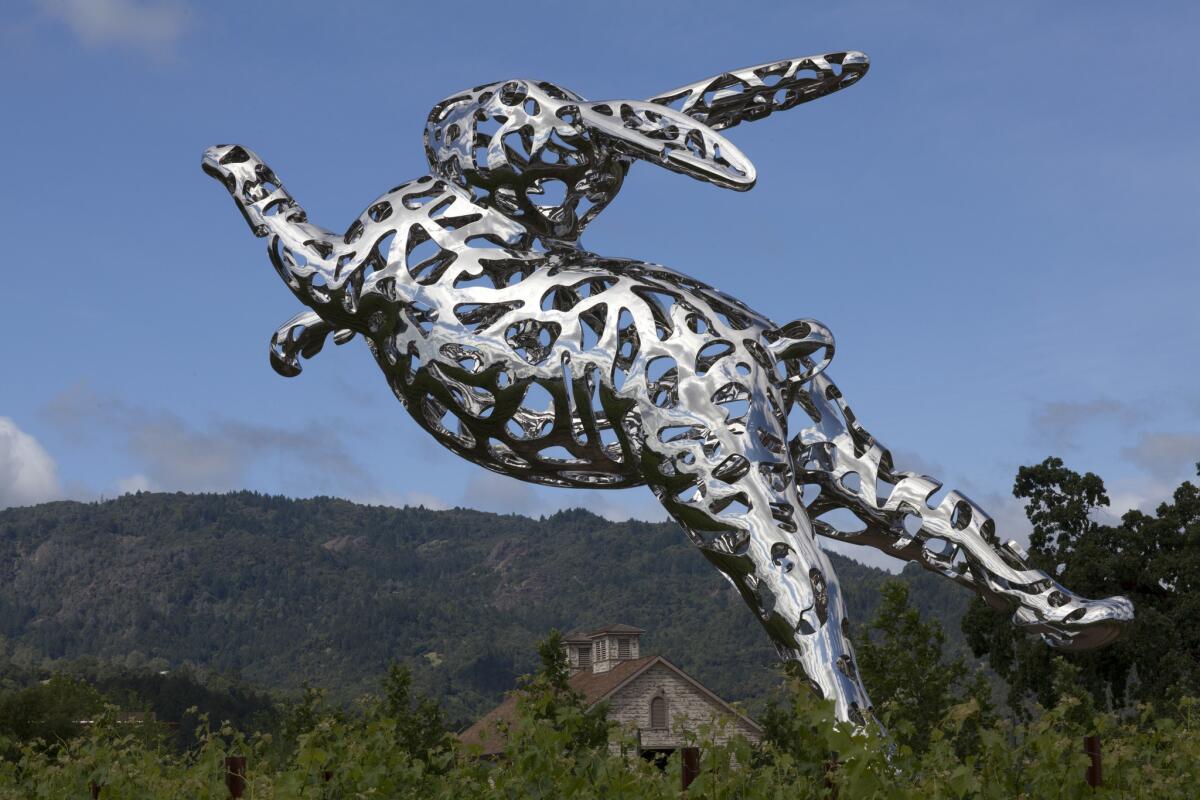
Vintner Kathryn Hall, who had a soft spot for the silly poem she shared with her children when they were young, commissioned the piece.
BFF, as it’s called, has made his way onto the Hall’s wine labels. At this time of year, you’ll find him toting a giant basket of Easter eggs.
Where to go, what to know: “Bunny Foo Foo” is pretty easy to catch at 401 St. Helena Highway. Hall winery, (707) 967-2626
Castroville, Calif.
The Giant Artichoke on Castroville’s main drag looks as though it’s squeezed between two buildings, but who wouldn’t stop to take a photo with a 20-foot-tall vegetable?
It was built in the early 1970s and belongs to the Giant Artichoke Restaurant next door.
There you can try artichoke nachos ($10.25), a meatless burger made with artichoke hearts and spinach ($10.75) and a fresh, steamed artichoke ($6.75).
Stick around for the Artichoke Festival on June 2 and 3 for more foods that take their cue from the spiky green thistle.

Where to go, what to know: The Giant Artichoke stands guard at 11261 Merritt St., Castroville. Don’t try to snap a photo as you drive by; park the car and take your time.
Salinas, Calif.
Three giant yellow hats stand as a love letter to the farm-proud town of Salinas. Artist Claes Oldenburg and his wife, Coosje van Bruggen, who died in 2009, designed the aluminum hats, which are almost 10 feet tall.
The three are staggered at different heights to convey the way a single hat would float to Earth after being tossed at a rodeo, fitting because Salinas is home to the California Rodeo Salinas, July 19-22 this year.
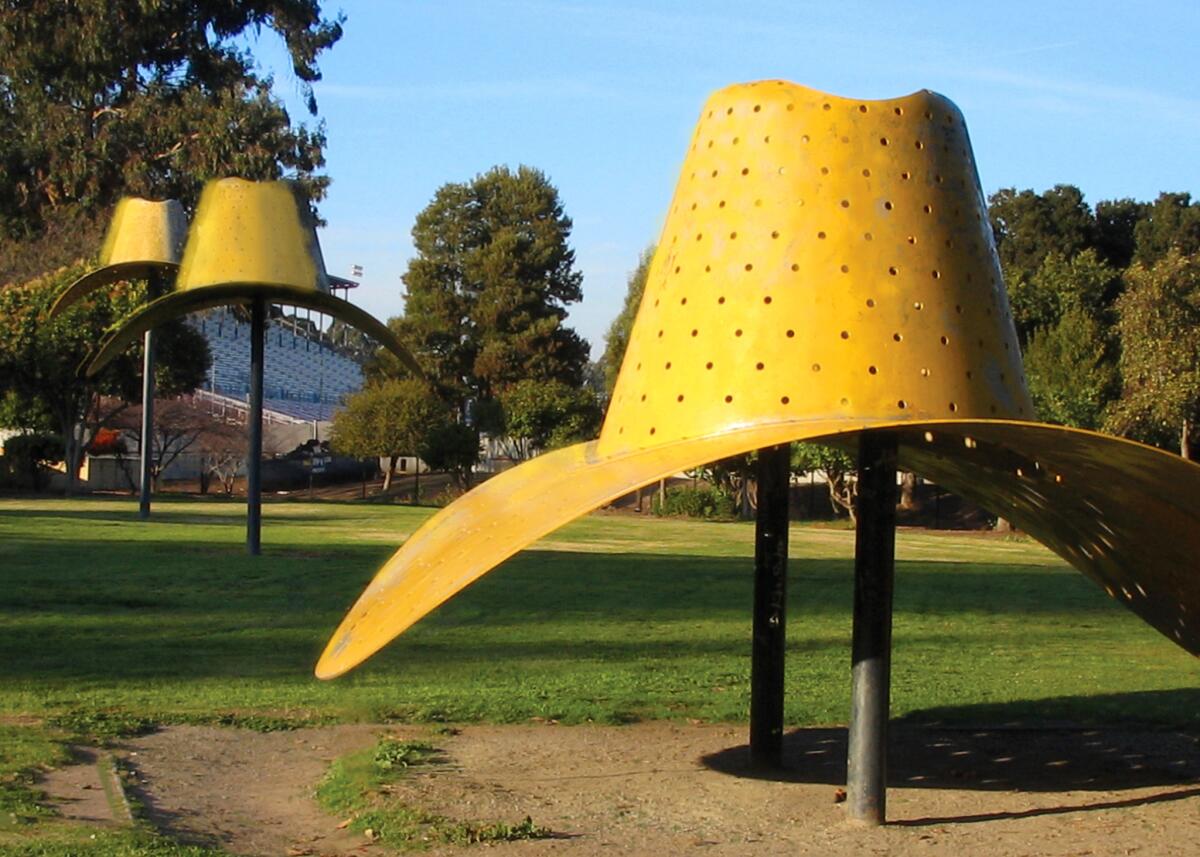
The artists painted them yellow, for the sun vital to the agricultural valley, and made a brim shaped like a saddle, a nod to the town’s western spirit.
Salinas is one of the smallest communities in the world to host an Oldenburg sculpture. You can get pretty close to the hats, but the trick is how to fit them in one photo.
Where to go, what to know: It’s free to visit what’s officially titled “Hat in Three Stages of Landing” at Sherwood Community Park, 940 N. Main St., Salinas. California Welcome Center, (831) 757-8687
Desert Hot Springs, Calif.
“Waokiye’”s weathered face seems appropriate for someone carved from a 750-year-old redwood.
The 1978 sculpture in Desert Hot Springs is part of a larger tribute to Native Americans by Hungarian-born artist Peter “Wolf” Toth, who created similar statues in every U.S. state and several Canadian provinces.
Not all survived, but “Waokiye” did. His face is 22 feet tall, and his head is topped with a massive 15-foot cedar feather, adding a touch of dignity and whimsy.
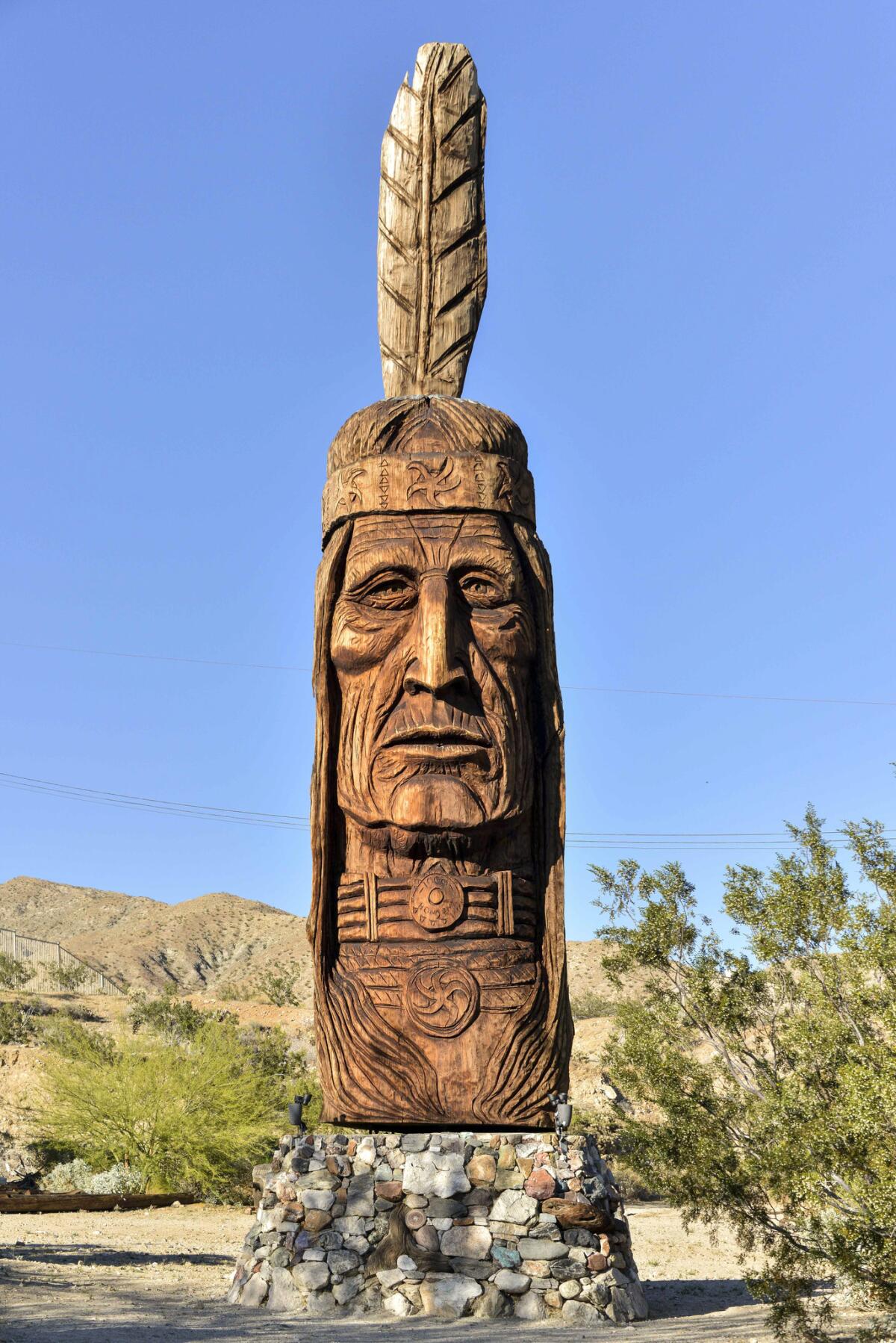
Toth, who lived in Hungary during the Soviet occupation, felt a kinship between the oppression his people suffered and the suffering of Native Americans.
The statue stands outside the Cabot’s Pueblo Museum, a Hopi-inspired pueblo built in 1941 as the residence of Cabot and Portia Yerxa.
Where to go, what to know: You can see “Waokiye” on your own or take a museum tour that also features Native American art collections in the 35-room former home. Cabot’s Pueblo Museum, 67616 E. Desert View Ave.
San Diego
Love it or hate it, you can’t deny the power of the “Kissing Statue.” It has been an off-and-on fixture at the Port of San Diego since 2007.
The 25-foot statue by Seward Johnson was inspired by a famous 1945 photograph of an exuberant sailor kissing a nurse in Times Square on the day the Japanese surrendered, effectively bringing World War II to a close.
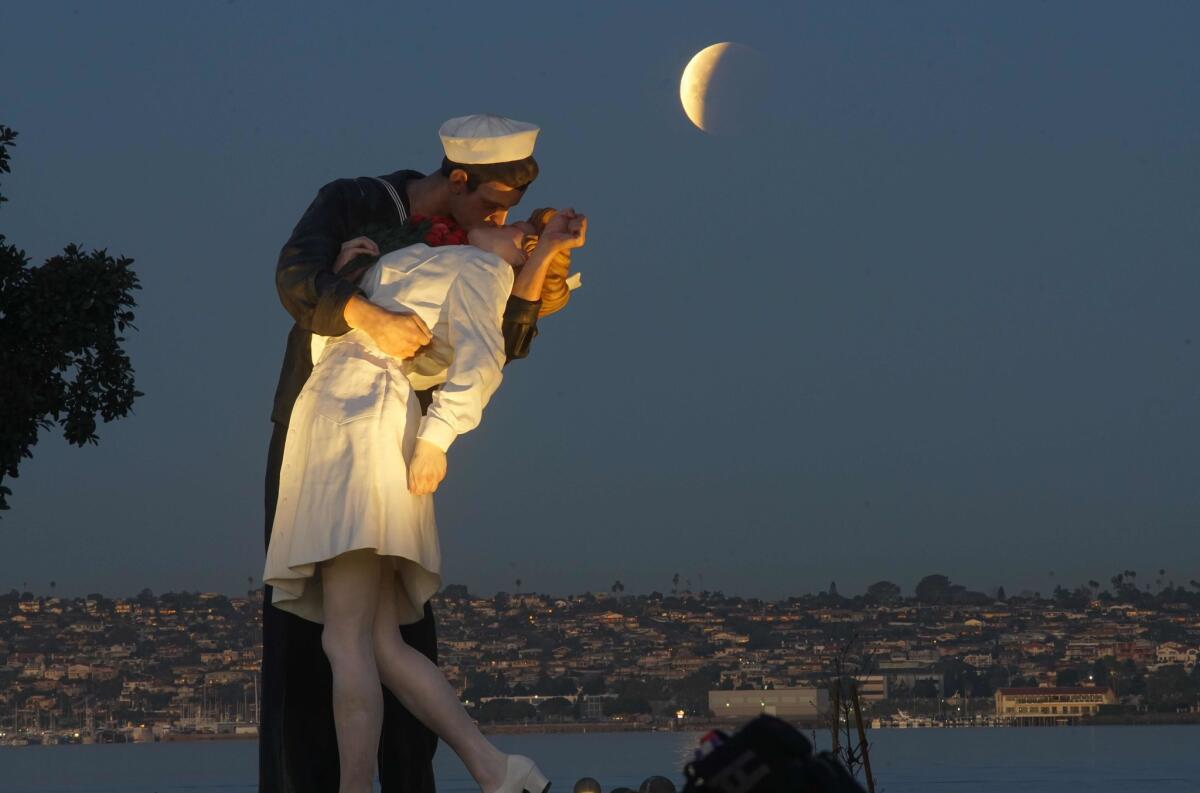
Critics have dismissed the artwork as tacky and gaudy, but don’t tell that to the hundreds of thousands who seek out the giant couple and share an identical kiss. Some even get married there.
The original “Unconditional Surrender” sculpture stood at Tuna Harbor Park until 2012. It was replaced by a sturdier painted bronze statue in 2013 — and the name changed to “Embracing Peace.”
Where to go, what to know: To get the full impact of the big, sloppy kiss, park your car and check it out on foot. There’s a grassy area, bench and views of San Diego Bay. Cosplay fans may be tempted to get in character — or not. Tuna Harbor Park, 3 Tuna Lane
Sign up for The Wild
We’ll help you find the best places to hike, bike and run, as well as the perfect silent spots for meditation and yoga.
You may occasionally receive promotional content from the Los Angeles Times.




